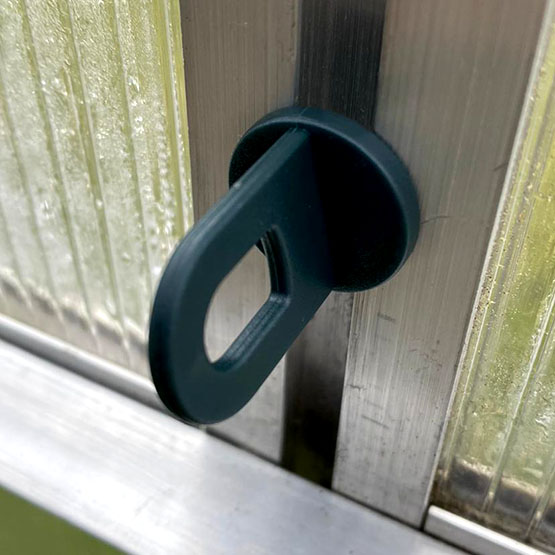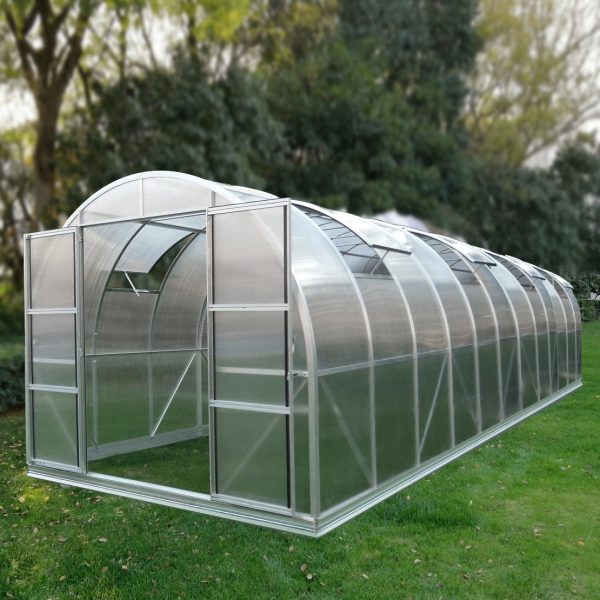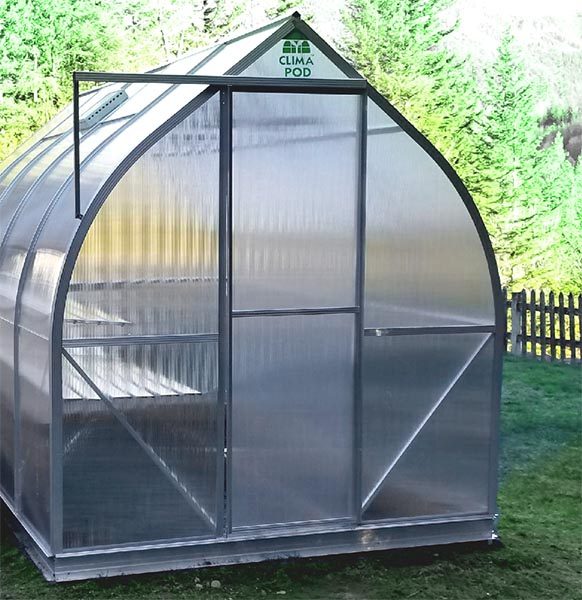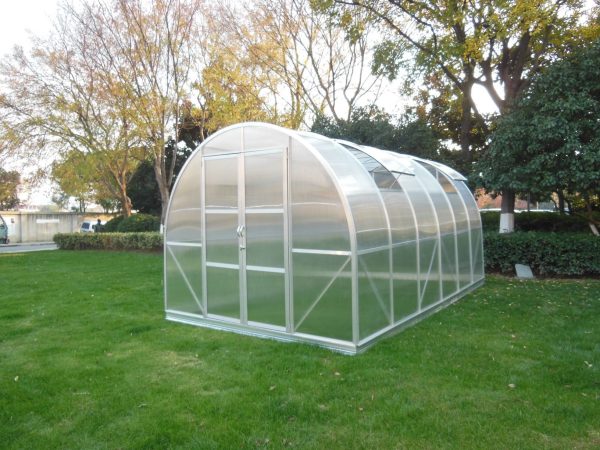Wouldn’t you agree that it makes no sense to look into buying a system without having an idea of how it works (at least on the basic level)? By learning and understanding how greenhouse work, you will be able to use its full capability and get the maximum benefits from it.
The most simple homemade plastic film greenhouses or complex industrial greenhouses – each greenhouse works on the basis of the same physical principles.
The Basic Principle of the Greenhouse Function
At the heart of the functioning of the greenhouse lies simple principles of physics – thermal radiation and heat exchange.
The greenhouse collects the incoming heat from the outside, turns it into heat, and keeps the warm air. That allows gardeners to keep a certain stable temperature level inside the greenhouse, creating the most favorable environment for the growth and livelihoods of horticultural crops.
In addition, the greenhouse protects both from the effects of the external environment – for example, weather conditions such as wind, hail, or snow, and from pests like beetles, locusts, and domestic and wild animals that could eat or damage your plants.
How Does Greenhouse Work?
Plants need enough warm temperature, light, water, air, and important nutrients to grow and survive. There are different requirements for different plants. A greenhouse functions by providing the light, warm temperature, and air that is critical for the plant’s survival. The rest of the elements such as water, nutrients, and additional necessities to support the plant’s growth are up to you.
These are the 5 Basic Steps on How Does a Greenhouse Work.
Step 1: The Sunlight is Trapped
In order to trap the light, greenhouses use many materials that are made mostly from transparent or translucent materials, like glass or plastic polycarbonate sheets. The trapped light provides the plants with enough access to sunlight.
Step 2: Sunlight is Converted into Energy
The plants and other elements in the greenhouse absorb the light and convert it to infrared energy (heat). Dark elements tend to absorb more energy and increase the greenhouse temperature. This is why the black surface gets really hot in the summer because it absorbs a lot of heat.
Step 3: The Heat Gets Trapped
Trapping the heat is one of the primary functions of the greenhouse called the “Greenhouse effect”. When the light is converted into infrared energy (heat), it takes a different form (wavelength). The transformation of the energy into a different wavelength makes it difficult for the heat to escape the greenhouse’s walls easily.
Step 4: Warming the Greenhouse
When the heat is trapped inside the greenhouse, it warms up the air inside. The warm air causes the temperature to increase inside the greenhouse. Since the greenhouse is relatively air-tight, the warmer air stays inside, and the temperature sustains for a longer period of time. No doubt you’ve experienced the same effect when you get into a car that is parked directly under the sun for a few hours.
Step 5: Supporting Photosynthesis
Sufficient light and enough warm temperatures provide ample conditions for the plants to grow. A sufficient amount of light and temperature allows photosynthesis to occur. Photosynthesis is the process by which plants synthesize nutrients (mainly sugar) from carbon dioxide from the air, energy from the sunlight, and water, which the plant then uses as food. Photosynthesis generally involves the green pigment in the plants called “chlorophyll” and produces oxygen as a by-product.

It is important to place your greenhouse where there is enough sunlight all day long to ensure that the plants inside get enough light. The plants averagely require about six hours of sunlight every day, although the sunlight requirements may vary depending on the type of plant you grow.
The Mechanism and the Physical Principles of the Greenhouse Function – How greenhouse work
Getting heat inside the greenhouse
The main task of the greenhouse is to utilize the thermal radiation received from the outside from the sun’s rays and/or artificial sources. Inside the walls of the greenhouse, thermal radiation turns into heat, heating the greenhouse from the inside.
This could be compared to the similar effect you could feel by closing all the windows inside the car on a hot summer day. If you do not start the engine and turn on the A/C, within only a few seconds the temperature inside your car will get significantly higher than outside and within minutes it could get extremely hot. This is because sunlight is heating the interior of your cabin, and there is no way to get the hot air outside with your doors closed.
The materials from which the greenhouses are made also affect the ability to retain heat and regulate the temperature inside the greenhouse. For example, polycarbonate is excellent as a material for a greenhouse due to its high coefficient of thermal expansion and high thermal stability. The greenhouse is a sealed room, and this makes it impossible for the air to circulate between the inner room of the greenhouse and the environment.
The air circulation equalizes the temperature difference, which could negate the main function of the greenhouse, especially during cold days. Without open-air circulation and with well-insulated walls, the air inside your greenhouse can quickly heat up creating ideal conditions for plant growth.
Temperature regulation in the greenhouse
Thermal radiation quickly heats the air inside the greenhouse and slowly heats up the soil. Warm air, in turn, contributes to the production and, most importantly, soil conservation of heat. Due to its organic properties, the soil is able to retain heat for a very long time, even when the source of thermal radiation becomes inactive. For example, in a simple greenhouse without heating, the soil heated by the sun on an average day keeps the heat received during the night.
But if the greenhouse is getting heated up infinitely, the temperature inside could soon become unsuitable for plants. The matter is that the function of a greenhouse promotes completely automatic thermoregulation.
So, how does temperature control work in a greenhouse. According to the laws of physics, the soil heats up in the daytime due to the fact that the air temperature in the greenhouse during the day is high. At night, when the temperature of the air without sunlight drops, the soil begins to give the stored heat by heating the air. Such a simple cycle creates a constant temperature regime inside the greenhouse.
In more advanced greenhouses, additional heating means are also used, which makes it possible to control and regulate thermoregulation without looking back at the weather. But even with heaters, the basic principle of obtaining-saving-recuperation of heat remains the same.
Greenhouse Ventilation – How greenhouse work
The ventilation system in the greenhouse plays an important role to maintain good plant health and improve crop production. Many greenhouse beginners complain about poor and slow growth, unsatisfactory yields, or various bacterial and fungus problems. All of these issues occur due to the inappropriate greenhouse ventilation system.
One of the most important uses of greenhouse ventilation is to control the heating of the greenhouse. Since temperature is one of the most important factors when it comes to the plant’s survival and growth. Not only is greenhouse ventilation important to maintain suitable growing conditions but they also directly impact the process of photosynthesis. Suitable greenhouse temperature is the key driving factor in the process of uptaking essential components and completing the plant’s reproductive cycles (aka pollination).
Greenhouse ventilation systems serve 3 critical functions:
Temperature Control
Greenhouse Ventilation systems serve the basic function of removing excess heat. Greenhouses work by trapping the sunlight resulting in a rise in the temperature inside the greenhouse (the greenhouse effect). The amount of heat required may vary from plant to plant, therefore, If this excess heat is not removed from the greenhouse then it can cause unsuitable conditions to grow certain types of plants or crops.
Humidity Control
Just like the heat, the humidity also gets trapped inside a greenhouse. Just like heat requirements in different plants, every plant requires different humidity conditions to grow. With high humid conditions, certain plants are troubled by pathogens that tend to grow in high humidity levels. Greenhouse ventilation is used to control humidity to provide a suitable environment for the plants as well as avoid the growth of such pathogens.
CO2 Replacement
Plants “breath” CO2 which is an important element of photosynthesis. Just as humans suffocate when the oxygen runs out in a poorly ventilated and enclosed area, sufficient CO2 must be replenished inside the greenhouse for the plants to survive.
Greenhouse ventilation systems help to maintain an adequate level of fresh air that guarantees a sufficient level of CO2 needed for the plant’s survival.
Protection against external influences
Another important purpose of the greenhouse is to protect your garden crops from the adverse effects of the external environment. In this respect, greenhouses perform the same function for plants as the house – for a person. Such protection is especially important in the autumn-winter season.
The greenhouse protects:
- The wind, which brings dust and seeds of weeds, blows out seedlings, and a strong wind can damage the plant and even tear it from the root. Strong greenhouses with a strong hull – the only outlet for windy regions (a well-made greenhouse will withstand a small storm).
- From precipitation. For example, by protecting plants from the rain, you yourself control how much water they will receive.
- Most pests. You will not need to treat plants with chemicals harmful to plants and to you. Of course, it’s impossible to prevent a single bug from entering the greenhouse, if only because some harmful insects can move underground, but significantly reduce the “presence” of pests on your vegetables, the greenhouse is fully capable.
Every agriculture enthusiast and gardener will agree that the greenhouse is something every gardener should have. Not only will it protect your plants, it will also give the ability to extend your growing season and in some regions grow year around.
Have you decided to buy a greenhouse? Choose the right model in the ClimaPod Greenhouse online-store here.






